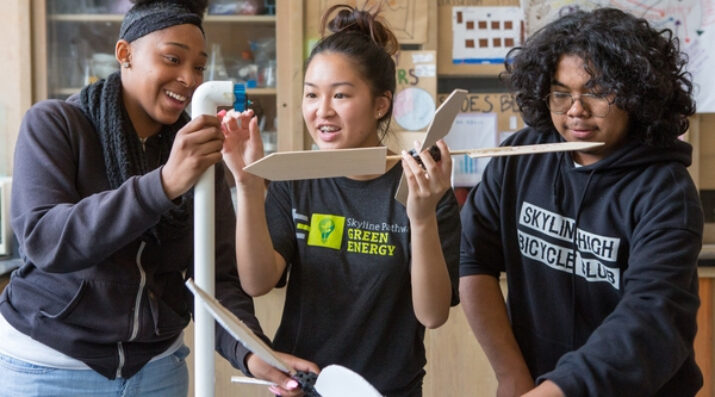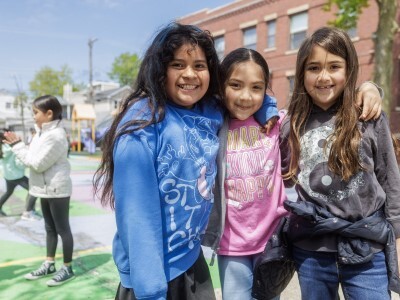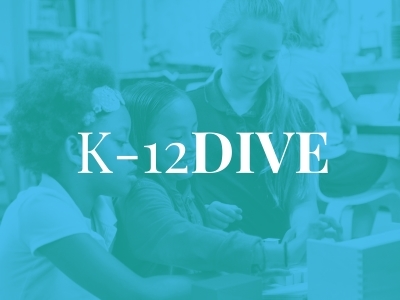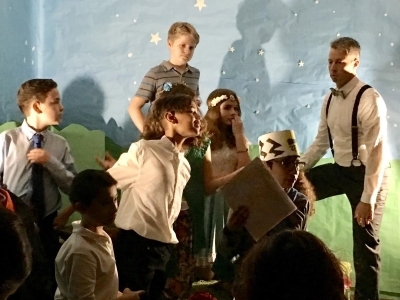Revival: Could Public Education Revive the Common Good?
Topics

Today’s learners face an uncertain present and a rapidly changing future that demand far different skills and knowledge than were needed in the 20th century. We also know so much more about enabling deep, powerful learning than we ever did before. Our collective future depends on how well young people prepare for the challenges and opportunities of 21st-century life.
What would you revive if you could revive something that has faded away? An exploration of the common good and the power of public education.
“What would you revive if you could revive something that has faded away?” Jessica, my wife, asked me. We were sitting at the dining room table basking in the late morning sun on one of those timeless days between Christmas and New Years when the mind wanders in a more expansive space and at a more slowed pace than during our usual crush. We were listening to an old CD of a band from New England, Nightingale, whose music is strongly influenced by Quebecois and Cape Breton folk traditions, in this case, hauntingly lyrical ballads of life in the harsh climes of northern New England and maritime Canada in times past. And we had been talking about Octavia Butler’s Parable of the Talents, her second in the Earthseed series, a near future dystopian novel that she wrote in the ’90’s that we found to be disturbingly prescient.
Part way through the novel, the main character, Lauren Oya Olamina, finds herself walking north up along a crumbling Interstate-5 through the Central Valley of northern California on her way to Oregon. She stops at a decrepit old farmhouse hoping to rest, and earn some money, or at least food and shelter, doing odd chores for a couple of days. There she befriends the wary owner, an older woman, Nia, who had been a teacher in San Francisco. Nia had retreated to this wilder and presumably safer place, where she tends her gardens and keeps out of sight. Butler writes:
“There were still a few public school systems in the country, limping along, doing what they could, but these had more in common with city jails than with even the most mediocre private, religious, or company schools. It was the business of responsible parents to see to the education of their children, somehow….
“‘So,’ Nia said, ‘poor, semiliterate, and illiterate people became financially responsible for their children’s elementary education. If they were alcoholics or addicts or prostitutes or if they had all they could do just to feed their kids and maybe keep some sort of roof over their heads, that was just too bad! And no one thought about what kind of society we were building with such stupid decisions. People who could afford to educate their children in private schools were glad to see the government finally stop wasting their tax money, educating other people’s children. They seemed to think they lived on Mars. They imagined that a country filled with poor, uneducated, unemployable people somehow wouldn’t hurt them!’”
This passage sent shivers down my spine. I didn’t have to think long to answer Jessica’s question: “A sense of the common good,” I said. “We need a revival of a sense of the common good.” It isn’t just this dystopian novel that predicts the consequences of “a country filled with poor, uneducated, unemployable people,” because, beyond the fictional accounting, we increasingly live in a real country filled with people who feel constant fear and a sense of the precarious nature of their lives, and a doubt about what the future might hold for them and their families. It is a whole, real, present place where people have narrowed their vision and lost a sense of what they owe each other, or can offer each other, in order to maintain a public space that is rich enough in resources to provide for the commonwealth (the common wealth), and thus the richness of life in community that a democracy can provide to its citizens. Tressie McMillan Cottom describes this as “the difference between a culture of mutual aid and [a culture of] charity” or philanthropy. Instead of “horizontal networks of solidarity… that flow in both directions and sustain the life of a community,” we seem to live in a place almost completely disabled by rampant individualism, a scarcity mentality, systemic racism, a deep fear of the coming climate catastrophe even while denying global warming even exists, and the ever present manipulations of consumerism and social media hype to prey on those fears, to prey on those insecurities, to get people to buy more and hoard more and share less with those less fortunate than they are.
The terrible irony of this loss is that it’s a downward spiraling feedback loop, as is pointed out in the “Tragedy of the Commons,” a theory that the British economist William Forster Lloyd first conceived in 1833. Competing for shared resources, and therefore depleting the “commons,” or withdrawing support entirely for the common good, whether that is public education or public health, ends up reinforcing individualism and a scarcity mentality, which feeds fear and uncertainty, which feeds back to reinforce an anti–common good mindset. And the only way out is to experience the positive results of an investment in the common good. The positive results of an investment in public education means people learn to understand the larger systems that they are part of and thus can develop the capacity to change for the better, in a setting that itself is made up of the diversity of the American people, not unlike a true public commons.
I had been talking about this phenomenon for a long time as an artifact of extractive capitalism, the same phenomenon that has been creating a widening income and wealth gap and a shrinking middle class for several decades. I was using “extractive” as a kind of metonymy, thinking of extractive industries like oil and gas and coal mining as a way to create a mental model for this more all-encompassing form of capitalism that extracts value, first from workers, in the traditional Marxist sense, then from the middle class to enrichen the upper classes, and then since the ’80’s from hostile takeovers of other companies and accumulation of intellectual property rights. This is the process by which the steel and logging industries (and the banking system, and then the overall investment system) were taken over by large investment firms that milked them dry. The investment firms bankrupted them under huge debt, thus destroying the local economies and communities that they were part of while also generating huge profits for the investors. Even recently, it is instructive to reflect on the story of the development of the mRNA vaccines for COVID-19. While currently the patents, and the profits, seem to belong mostly to Moderna and Pfizer, it turns out that the story involves hundreds of scientists over several decades who did the complex work, and who worked mostly in small labs all over the world, often struggling for funding, often funded by government research grants.
But the other day I received a very interesting email, forwarding a short piece about “rentier capitalism and the new precariat,” by a man named Guy Standing. I was both elated and horrified. You know how you feel when something you’ve been talking and thinking about for several years all of a sudden gets a name and a category for it that you didn’t know existed, but that is about some phenomenon that you know for certain is really bad news? All of a sudden I realized that what was happening was way worse than extractive capitalism, and way worse than rampant individualism and insecurity preyed upon by consumer forces. My wish to revive a belief in and a practice of the common good all of a sudden seemed much more relevant and urgent.
There are few other places in our current social, political, or economic systems where we get this kind of opportunity to practice and develop the skills to live as decent citizens
Wikipedia defines rentier capitalism as a form of capitalism that allows (and deregulates to promote) the gaining of rentier income from ownership or control of assets that generate “economic rents,” rather than from capital or labor used for production in a free competitive market. It’s basically income earned without your own labor or production of anything, from investing the profits you might have gotten from someone else’s labor, or from the intellectual property rights you gain from owning or buying someone else’s effort. The problem is that these “rents” are extracted from workers and communities without the rentier contributing back to the community. According to Standing, the biggest advocates for this system, and the biggest beneficiaries of it, turn out to be Big Tech, Big Pharma, and Big Finance, along with Big Agriculture. Outsized companies that monopolize an industry contribute to the decline of the economic worth of those workers, their businesses, and their communities, and as a result cause increasing uncertainty and sense of the precarious nature of life in general, hence the term, precariat, a portmanteau of precarious and proletariat, as the new class structure that is created. They decimate the “commons.”
About rentier capitalism and the new precariat, Guy Standing wrote:
“Full transition to rentier capitalism came in 1994, with the passage of TRIPS (Trade-Related Aspects of Intellectual Property) by what became the WTO. This globalised the US intellectual property rights (IP) system. Henceforth, in an unprecedented way every technical change gained huge rental income, giving their owners monopoly income for 20 years or more and the power of hoovering patents and other forms of IP, fostering conglomeration, higher price mark-ups over production costs, plutocratic corporations, and a plutocracy manipulating politics, the media, our education, and our consciousness. By 2020, over 15 million patents were in force, and over three million are filed each year.
“As with previous technological revolutions, a new class structure has emerged, with a new mass class, the precariat, facing patterns of exploitation and oppression unlike the old proletariat or earlier mass classes, the remnants of which persist. The insecurities, interests, and aspirations of the vanguard of this class differ profoundly from those of the proletariat when it was confronting Fordism and Taylorism…”
What does all this have to do with my desire to revive the common good, and what does it have to do with public education, you might ask. Public education could be the place where there is enough critical thinking and learning about how we are embedded in these destructive systems to enable agency to stop the process. However, support for public education has suffered from the dynamic interactions between the decline in belief in the common good (the quote above from Octavia Butler seems appropriate here) and the rise of rentier capitalism and the precariat. It’s a strange brew.
To be honest, I’ve always believed, since I was a teenager, that public education was the site for social transformation. Public education is the place where we practice living and interacting in the commons in small ways so that once we are older we can live in the commons as a civic responsibility. Jal Mehta cites David Perkins as calling this, “Playing the whole game at a junior level.” Public education, or actually, courageous teachers, could be the countervailing force creating a positive feedback loop by reversing the downward spiraling loop caused by the interaction of fear and resistance of individuals to positive participation in the common good with the forces of rentier capitalism. Public education could be how we come to have the habits of mind and heart to be able to live believing in and supporting the balanced use of the common wealth for the common good. There are few other places in our current social, political, or economic systems where we get this kind of opportunity to practice and develop the skills to live as decent citizens. In a good school teachers create spaces where students from all backgrounds come together, learn to support each other, learn to work together, and engage together in authentic work with real world consequences. This is not just about civics education as a content area; it’s about the experiences students have that build their capacity for civic engagement through sustained practice with, paraphrasing Jessica Forbes and Ron Berger:
Work that matters (that is, meaningful to the students); the opportunity to engage in productive struggle with ‘texts’ (of various kinds); opportunities for voice, choice, and agency; iterations of practice and revision of work towards high standards of quality, with feedback from teachers and peers; thus, learning that is active and sustained over time, that elicits rigorous and joyful engagement; involves creating knowledge rather than just receiving information; and with authentic audiences, and purposes, for the products students create that demonstrate their learning.
Some, but not enough, adults have this much of an experience of authenticity and agency in our interactions with each other in the public commons. If more did, we might feel as committed to reviving it as students who experience this kind of learning feel. So, now I ask you the same question Jessica asked me, what would you revive that has faded away? I hope you will consider not just the common good, but a universal commitment to the power that can be had from a good public education. It may be our only chance to confront rentier capitalism and replace the precariat with a strong middle class again, and to keep from living into the dystopian near future that Octavia Butler horrifyingly describes for us in her writing.
Photo at top by Allison Shelley/The Verbatim Agency for EDUimages, CC BY-NC 4.0




